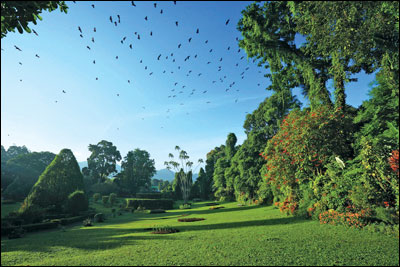Delightful study of Lankan gardens
Gardens of Lanka. (Edited by Sarala Fernando, Photographs by
Luxshmanan Nadaraja.) Colombo (2009), 227 pp., printed in Singapore on
lumisilk paper, shrink-wrapped. Rs. 6500 (Rs. 4500 before 30 Nov. call
011-2861738 or email:[email protected]).
A delightful book. This production is being launched at a time when
the country is re-energising herself after a long and debilitating
conflict, which sapped her human and material resources. It could help
in re-building our pride in our country and her people.
Resources
'Gardens of Lanka' is a compilation of Sri Lanka's garden history
with its ancient roots and features such as the transformation of royal
parks into monastic sites and reflecting also some early diplomatic
relations and the variety of garden styles, inherited and created, in
different locations around the country. The photographs are enchanting.

The subjects selected as illustrations would do credit to comparable
publications from any part of the world. Add to this Nadaraja's skills
as a photographer. This came home to this reviewer with a photograph
titled 'Laki's favourite garden, Kotte', which appears before the formal
text opens. There is a little dog looking at the photographer
inquiringly and providing a perfect balance in a vast garden. This
little bit of serendipity whets the expectation of the reader for what
lies ahead.
While the photographs form the core of the book, the editors have
assembled articles from a number of well-known personalities to provide
detail in respect of most of the various subject areas addressed. The
latter include 1) Royal Gardens (Sigiriya and Anuradhapura), 2) Monastic
Gardens, 3) The Lotus Pond, 4) Herbal and Spice Gardens, 5) Lost
Gardens, 6) The National Botanic Gardens in Sri Lanka, 7) The History of
Gardening in Sri Lanka, 8) Up-Country Gardens, 9) Traditional Home
Gardens of Kandy, 10) A Jaffna Courtyard, 11) Gardens from the Eastern
Province, 12) Orchids, 13) Experiencing the Trees in the Landscape, 14)
The Borrowed Garden - The Landscape Commons, 15) Birds in the Sri Lanka
Home Garden, 16) The Bawa Gardens, 17) Diyabubula - A Dry Zone Water
Garden, 18) A Collector in the Village, 19) Village Home Gardens and 20)
Private Gardens.
Diplomacy
Sarala Fernando, who edited the text, has been a career diplomat and
since retirement is engaged in academic work. This background in
diplomacy and canvassing the country's interests at home and abroad has
had the happy outcome of transforming the present production from what
might have been a regular 'coffee table book' (albeit with exquisite
photographs) into something of considerably more substance.
Space considerations do not permit review of each subject area
covered. However, in the Introduction ('Journey of Exploration'), it is
noted that the diplomatic and archaeological histories of the island
find special consideration, notwithstanding this being a book devoted
essentially to 'Gardens'.
For instance, in connection with the gift in the 3rd century B.C.
from Indian Emperor, Asoka, to Lanka's king Devanampiyatissa of a
sapling of the sacred bo tree (Ficus religiosa), it is said that 'the
planting of fig trees was both an act of merit and a means of ratifying
peace treaties'.
There is mention, also, that the 'Sri Ma Bo' of Anuradhapura is 'the
oldest historically recorded tree in the world and the earliest monument
that survives in Sri Lanka'.
A couple of personal observations may not be out of place. In the
interests of conserving indigenous plant species, well-motivated
individuals, who come across an interesting specimen in the wild,
sometimes take it for cultivation in their home garden, which may be in
another region of the country.
Pollinator
As a conservation measure, this is very often unsuccessful.
Particularly in the case of orchids, 1) climatic conditions may be
unsuitable for even a healthy plant to thrive and flower, 2) the
unfamiliar climatic conditions may render the plant susceptible to
disease, 3) even if the plant survives and flowers, the specific
pollinator may not be present in the new location and 4) even if
pollination is effected, orchid seeds are notoriously difficult to
germinate and grow except under specific conditions. Indigenous orchid
species are best conserved in situ or at least in their native region.
The Department of Archaeology earlier permitted indigenous orchid
plants to be transferred to archaeological sites in the locality for
this purpose.
Similarly, the Mahaweli Authority of Sri Lanka earlier gave
permission for the Karawiladukande Island in the Randenigala Reservoir
to be used as a plant sanctuary. Hopefully, the measures are still in
force. Other state and private institutions may like to help in this
cause and apprise the public of available locations.
Shereen Amendra's characteristically innovative discussion titled
'The borrowed garden - The landscape commons' brought back memories of
the time some years back when she and this reviewer served on a
committee set up to advise the Mayor of Colombo on environmental
matters. Some top-flight professionals, who in another country would
have been handsomely rewarded for their services, donated their time and
knowledge at no charge over many months in support of this work.
Dr. Rohan H. Wickramasinghe |



